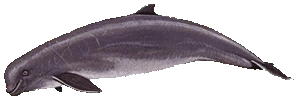|
|
|
|
|
Back to the main menu of species Heaviside's Dolphin 
Scientific Name: Cephalorhynchus heavisidii Other Names: South African Dolphin, Benguela Dolphin Length: 5.3-5.8 ft. (1.6-1.7 m.) Weight: 90-165 lbs. (40-75 kg.) Teeth: 88-114 The heaviside's dolphin lives in remote
areas and is generally shy. Their bodies are similar to hector's dolphins. They
have small, triangular like dorsal fins. However, the leading edges of their
dorsal fins are longer than the trailing edges. These dolphins have been seen
bow-riding, wake-riding, and escorting ships. It appears that some pods have
home ranges and do not travel far outside these ranges.
Hector's Dolphin 
Scientific Name: Cephalorhynchus hectori Other Names: Little Pied Dolphin, New Zealand Dolphin Length: 4-5 ft. (1.2-1.5 m.) Weight: 75-130 lbs. (35-60 kg.) Teeth: 106-130 This dolphin may appear dark at a distance,
but it has a complex pattern of white, gray, and black. The shape of its dorsal fin
makes it easy to distinguish from other marine mammals. Unlike most dolphins, males
are generally smaller than the females. Hector's dolphins rarely bow-ride, however,
they wake-ride and follow alongside slow ships. These dolphins prefer to associate
with slow or stationary ships over fast ones (over 10 knots) and may even avoid
faster ships.
Hourglass Dolphin 
Scientific Name: Lagenorhynchus cruciger Other Names: Wilson's Dolphin Length: 5.3-6 ft. (1.6-1.8 m.) Weight: 200-265 lbs. (90-120 kg.) Teeth: 100-104 The hourglass dolphin was named for the
hourglass patterns on its sides. It lives in arctic regions, therefore, it
is difficult to study and little is known about it. It does have a stocky
body and a well defined rostrum. When they swim, they tend to have s
smooth undulating motion. The hourglass dolphin is currently the only
dolphin with a dorsal fin constantly found in the southern hemisphere Indo-Pacific Hump-Backed Dolphin 
Scientific Name: Sousa chinensis Other Names: Humpback Dolphin, Speckled Dolphin Length: 6.5-9.3 ft. (2-2.8 m.) Weight: 330-440 lbs. (150-200 kg.) Teeth: 116-152 The classification of the hump-backed
dolphins is still in dispute, however, most authorities currently accept only two
species (the Atlantic Hump-Backed dolphin and the Indo-Pacific Hump-Backed
dolphin). These dolphins feed in shallow water on fish, mollusks, and crustaceans.
They use their echolocation when searching for their prey.
Irrawaddy Dolphin 
Scientific Name: Orcaella brevirostris Other Names: Snubfin Dolphin Length: 7-8.5 ft. (2.1-2.6 m.) Weight: 200-330 lbs. (90-150 kg.) Teeth: 62-76 Irrawaddy dolphins inhabits fresh water
as well as marine water. They can travel ten miles or more up river. Like beluga
whales, these dolphins also possess flexible necks and bodies. They are slow
swimmers and surface with a slow, smooth roll. There have been reports of these
dolphins cooperating with fishermen by driving fish into fish nets.
Please dont forget to sign my guestbook as I love getting mail.Sign my Dreambook! |